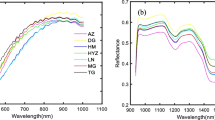Abstract
133 camelina samples were used to build the Fourier transform infrared (FT-IR) prediction model. Several methods have been used for the establishment of the predicting model, but support vector machine was rarely used in FT-IR area to build the prediction model. The aim of this study was to develop a new model for predicting protein with higher accuracy. In the spectra region 690–1700 cm\(^{-1}\), the SVM method was better than that of PLS and PCR. In the development of SVM, the \(\hbox {R}_{\mathrm{RMSEC}}^{2}\) and \(\hbox {R}_{\mathrm{RMSEP}}^{2}\) of the model were 0.83963 and 0.96578 respectively, and the RPD was 5.5016. The RPD was greater than that of PLS and PCR. The FT-IR was effective in predicting the content of camelina protein and SVM was a better method to build prediction model.




Similar content being viewed by others
References
Kagale, S., Chushin, K., Nixon, J., et al.: The emerging biofuel crop Camelina sativa retains a highly undifferentiated hexaploid genome structure. Nat. Commun. 5(4), 3706 (2011)
Zubr, J.: Oil-seed crop: Camelina sativa. Ind. Crops Prod. 6(2), 113–119 (1997)
Li, Y., Sun, X.S.: Camelina oil derivatives and adhesion properties. Ind. Crops Prod. 73, 73–80 (2015)
Ryhanen, E.L., Perttila, S., Tupasela, T., et al.: Effect of Camelina sativa expeller cake on performance and meat quality of broilers. J. Sci. Food Agric. 87(8), 1489–1494 (2010)
Rokka, T., Alen, K., Valaja, J., et al.: The effect of a Camelina sativa enriched diet on the composition and sensory quality of hen eggs. Food Res. Int. 35(2–3), 253–256 (2002)
Li, N., Qi, G., Sun, X.S., et al.: Adhesion properties of camelina protein fractions isolated with different methods. Ind. Crops Prod. 69, 263–272 (2015)
Zhang, K., Tan, Z., Chen, C., Sun, X.S., et al.: Rapid prediction of camlina seed oil content using near-infrared spectroscopy. Energy Fuels 31(5), 5629–5634 (2017)
Xu, F., Yu, J., Tesso, T., et al.: Qualitative and quantitative analysis of lignocellulosic biomass using infrared techniques: a mini-review. Appl. Energy 104(2), 801–809 (2013)
Benesch, M.G., Lewis, R.N., Mannock, D.A., et al.: A DSC and FTIR spectroscopic study of the effects of the epimeric cholestan-3-ols and cholestan-3-one on the thermotropic phase behavior and organization of dipalmitoylphosphatidylcholine bilayer membranes: comparison with their 5-cholesten analogs. Chem. Phys. Lipids 188, 10–26 (2015)
Wu, Z., Zhao, Y., Zhang, J., et al.: Quality assessment of gentiana rigescens from different geographical origins using FT-IR spectroscopy combined with HPLC. Molecules 22(7), 1238 (2017)
Porras, M.A., Cubitto, M.A., Villar, M.A.: A new way of quantifying the production of poly(hydroxyalkanoate)s using FTIR. J. Chem. Technol. Biotechnol. 91(5), 1240–1249 (2016)
Wu, Z., Xu, E., Long, J., et al.: Use of attenuated total reflectance mid-infrared spectroscopy for rapid prediction of amino acids in Chinese rice wine. J. Food Sci. 80(8), C1670 (2015)
Seung Yeob, S., Young Koung, L., In-Jung, K.: Sugar and acid content of Citrus prediction modeling using FT-IR fingerprinting in combination with multivariate statistical analysis. Food Chem. 190, 1027–1032 (2016)
Kumar, M., Raghava, G.P.: Prediction of nuclear proteins using SVM and HMM models. BMC Bioinf. 10(1), 22–22 (2009)
Liu Jun, Wu, Mengting, Tan Zhenglin, et al.: Overview of data analysis methods in near-infrared spectroscopy nondestructive testing. J. Wuhan Inst. Technol 39(05), 496–502 (2017)
Cherkassky, V., Mulier, F.: Statistical learning theory. Encycl. Sci. Learn. 41(4), 3185–3185 (1998)
Shao, W., Li, Y., Diao, S., et al.: Rapid classification of Chinese quince (Chaenomeles speciosa, Nakai) fruit provenance by near-infrared spectroscopy and multivariate calibration. Anal. Bioanal. Chem. 409(1), 115–120 (2017)
Ulrichs, T., Drotleff, A.M., Ternes, W.: Determination of heat-induced changes in the protein secondary structure of reconstituted livetins (water-soluble proteins from hen’s egg yolk) by FTIR. Food Chem. 172, 909 (2015)
Kyomugasho, C., Christiaens, S., Shpigelman, A., et al.: FT-IR spectroscopy, a reliable method for routine analysis of the degree of methylesterification of pectin in different fruit- and vegetable-based matrices. Food Chem. 176, 82–90 (2015)
Acknowledgements
This work was supported by the Hubei Provincial Department Education Science Technology Research Program—Outstanding Youth Talent Project (HPSFY#Q20111504), the ninth Graduate Innovation Fund of Wuhan Institute of Technology and the Foundation of Hubei Provincial Key Laboratory of Intelligent Robot (HBIR 201608).
Author information
Authors and Affiliations
Corresponding authors
Rights and permissions
About this article
Cite this article
Liu, J., Wu, M., Wang, M. et al. Predicting the content of camelina protein using FT-IR spectroscopy coupled with SVM model. Cluster Comput 22 (Suppl 4), 8401–8406 (2019). https://doi.org/10.1007/s10586-018-1838-3
Received:
Revised:
Accepted:
Published:
Issue Date:
DOI: https://doi.org/10.1007/s10586-018-1838-3




